精编中考英语阅读理解主旨大意题目专项训练
初三英语阅读理解主旨大意和细节题综合单选题30题
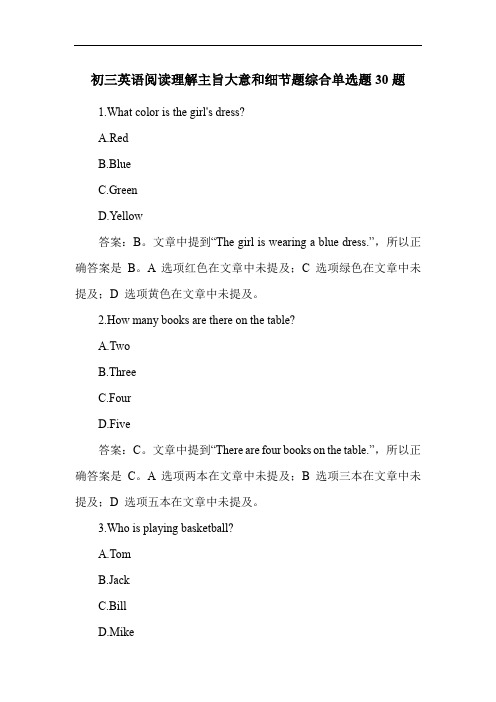
初三英语阅读理解主旨大意和细节题综合单选题30题1.What color is the girl's dress?A.RedB.BlueC.GreenD.Yellow答案:B。
文章中提到“The girl is wearing a blue dress.”,所以正确答案是B。
A 选项红色在文章中未提及;C 选项绿色在文章中未提及;D 选项黄色在文章中未提及。
2.How many books are there on the table?A.TwoB.ThreeC.FourD.Five答案:C。
文章中提到“There are four books on the table.”,所以正确答案是C。
A 选项两本在文章中未提及;B 选项三本在文章中未提及;D 选项五本在文章中未提及。
3.Who is playing basketball?A.TomB.JackC.BillD.Mike答案:A。
文章中提到“Tom is playing basketball.”,所以正确答案是A。
B 选项杰克在文章中未提及在打篮球;C 选项比尔在文章中未提及在打篮球;D 选项迈克在文章中未提及在打篮球。
4.What time does the movie start?A.7:00B.7:30C.8:00D.8:30答案:B。
文章中提到“The movie starts at 7:30.”,所以正确答案是B。
A 选项7 点在文章中未提及是电影开始时间;C 选项8 点在文章中未提及是电影开始时间;D 选项8 点30 在文章中未提及是电影开始时间。
5.Where is the post office?A.Next to the bankB.Beside the schoolC.Opposite the parkD.Behind the library答案:A。
文章中提到“The post office is next to the bank.”,所以正确答案是A。
2023年中考英语专项复习+阅读理解之主旨大意
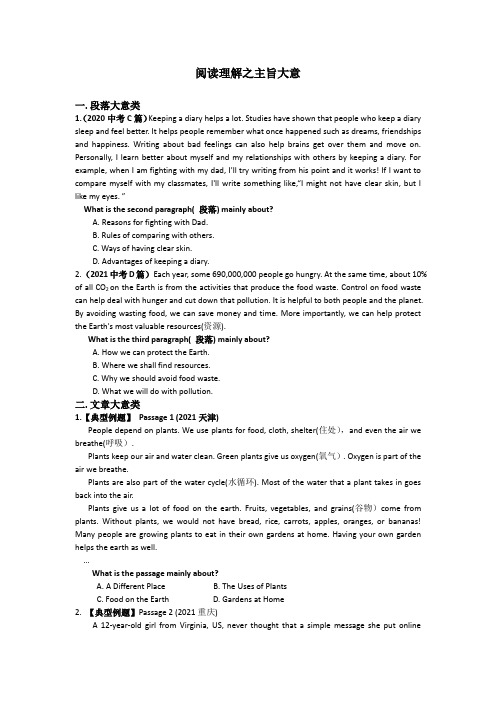
阅读理解之主旨大意一.段落大意类1.(2020中考C篇)Keeping a diary helps a lot. Studies have shown that people who keep a diary sleep and feel better. It helps people remember what once happened such as dreams, friendships and happiness. Writing about bad feelings can also help brains get over them and move on. Personally, I learn better about myself and my relationships with others by keeping a diary. For example, when I am fighting with my dad, I'll try writing from his point and it works! If I want to compare myself with my classmates, I'll write something like,“I might no t have clear skin, but I like my eyes. ”What is the second paragraph( 段落) mainly about?A. Reasons for fighting with Dad.B. Rules of comparing with others.C. Ways of having clear skin.D. Advantages of keeping a diary.2.(2021中考D篇)Each year, some 690,000,000 people go hungry. At the same time, about 10% of all CO2 on the Earth is from the activities that produce the food waste. Control on food waste can help deal with hunger and cut down that pollution. It is helpful to both people and the planet. By avoiding wasting food, we can save money and time. More importantly, we can help protect the Earth's most valuable resources(资源).What is the third paragraph( 段落) mainly about?A. How we can protect the Earth.B. Where we shall find resources.C. Why we should avoid food waste.D. What we will do with pollution.二.文章大意类1.【典型例题】Passage 1 (2021天津)People depend on plants. We use plants for food, cloth, shelter(住处),and even the air we breathe(呼吸).Plants keep our air and water clean. Green plants give us oxygen(氧气). Oxygen is part of the air we breathe.Plants are also part of the water cycle(水循环). Most of the water that a plant takes in goes back into the air.Plants give us a lot of food on the earth. Fruits, vegetables, and grains(谷物)come from plants. Without plants, we would not have bread, rice, carrots, apples, oranges, or bananas! Many people are growing plants to eat in their own gardens at home. Having your own garden helps the earth as well.…What is the passage mainly about?A. A Different PlaceB. The Uses of PlantsC. Food on the EarthD. Gardens at Home2.【典型例题】Passage 2 (2021重庆)A 12-year-old girl from Virginia, US, never thought that a simple message she put onlinecould bring her big problems. She posted the words, “Killing. Meet me in the library Tuesday", with three emojis(表情符号) of a gun, a knife and a bomb(炸弹) on Instagram, a social media(社交媒体). She was told that she broke the law because of threatening(威胁) her school.This problem is not far away from us. Not long ago, Ni Hanxiang, a Chinese student at a university in the US, was sent back to China after expressing on social media that he could kill his teachers if he failed to pass his examsBut not knowing the law doesn’t mean the law will treat you any differently if you break it, "says David Allen Green, a l awyer from the UK. So, do you think we’d better spend a minute or two thinking about the words or emojis we use on social media before we press "send"?This passage mainly wants to tell us that______________.A. we shouldn't break the US law if we study at a university in the USB. students and singers shouldn't post words or emojis on social mediaC. we should be careful when we send words or emojis on social mediaD. students should study hard at school and not use the Internet too much3.【典型例题】Passage 3 (2019重庆)Paper cut can be seen in many parts of China during the Spring Festival. People put it on windows, doors and walls for the festival.A thousand years ago, paper cut was used for decoration (装饰). In Tang Dynasty women used paper cut as headdress. In Song Dynasty, it helped make girls more beautiful. What's more, people would feel happier when they saw paper cut on windows, doors and walls.There are different kinds of paper cut in different parts of China. Pictures usually cover nearly all things, from flowers. birds to the famous people. Now, there are factories for paper cut in China. Paper cut has changed from decoration to a kind of art.This passage is mainly about_______________.A.CartoonsB. TV programsC. paper cutD. hair cut三.最佳标题类1. Xiao Liuying is an old man living in a village near the Yangtze River. He used to be afisherman. But now he is head of a voluntary(志愿的) team that cleans waste from the Yangtze River.To protect finless porpoises(江豚) and the Yangtze River, the government has stopped people from fishing on the river. In 2019, Xiao Liuying formed the voluntary team with 12 other fishermen. Today the team has more than 50 members. All of them are over 60 years old. “We want to protect the river while we can," said Xiao.Every week, the team go along the river to collect waste and make sure no one is fishing on the river. Some of the waste they collect is sent to the disposal station, while some that can be reused is sold. So far, they have cleaned over 50 tons of waste. Thanks to their hard work, the Yangtze River is getting clearer.What is the best title(标题) for the text?A.Fishing on the Yangtze RiverB.Tons of Waste in the Yangtze RiverC. Reasons for Protecting the Yangtze RiverD. A Voluntary Team Protecting the Yangtze River2. Sometimes I really doubt whether there is love between my parents. Every day they are verybusy trying to make money for my schooling.One my mother was sewing a quilt(缝被子). I silently sat beside her。
中考英语阅读理解主旨大意概括准确单选题40题
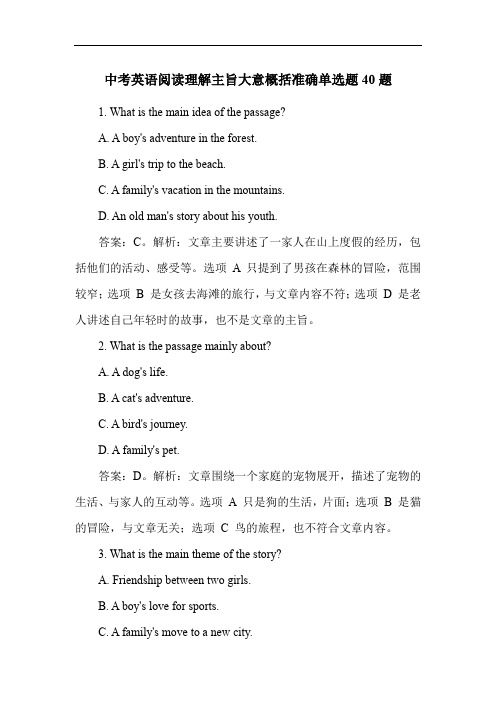
中考英语阅读理解主旨大意概括准确单选题40题1. What is the main idea of the passage?A. A boy's adventure in the forest.B. A girl's trip to the beach.C. A family's vacation in the mountains.D. An old man's story about his youth.答案:C。
解析:文章主要讲述了一家人在山上度假的经历,包括他们的活动、感受等。
选项A 只提到了男孩在森林的冒险,范围较窄;选项B 是女孩去海滩的旅行,与文章内容不符;选项D 是老人讲述自己年轻时的故事,也不是文章的主旨。
2. What is the passage mainly about?A. A dog's life.B. A cat's adventure.C. A bird's journey.D. A family's pet.答案:D。
解析:文章围绕一个家庭的宠物展开,描述了宠物的生活、与家人的互动等。
选项A 只是狗的生活,片面;选项B 是猫的冒险,与文章无关;选项C 鸟的旅程,也不符合文章内容。
3. What is the main theme of the story?A. Friendship between two girls.B. A boy's love for sports.C. A family's move to a new city.D. An old woman's memories.答案:A。
解析:故事主要讲述了两个女孩之间的友谊,包括她们一起经历的事情等。
选项B 男孩对运动的热爱不是文章重点;选项C 家庭搬到新城市与文章不符;选项D 老妇人的回忆也不对。
4. What is the main purpose of the passage?A. To describe a beautiful garden.B. To tell a funny story.C. To introduce a famous person.D. To explain a scientific concept.答案:B。
中考英语阅读理解主旨大意题目专项训练

精编中考英语阅读理解主旨大意题目专项训练AHow green are you? Do you know how to be green?We all need a healthy environment, but we produce waste every day and it does harm to our environment. Though we are young, we can still do something to help. In fact, even the simplest everyday activities can make a real difference to the environment. Here are some ideas for you. ReduceReduce means “use less ”. Don ’t waste things. This saves money and reduces pollution and waste going into the environment. Before we buy something new, think whether it is really necessary —or maybe the old one will be just as good! When we do buy things, choose local products if possible, and try not to buy too many things from abroad. ReuseReuse means “use again ”. Use things for as long as possible. When we buy things, make sure that they last a long time. We should look after them so that they will last, and we should repair them if we can instead of throwing them away and buying new ones. Don ’t use a paper cup of a paper bag. It ’s better to use a china cup and a lunchbox because you can use them again. RecycleRecycle mea ns “change things into something else ”. Though it takes energy to changesomething into something else, it ’s better than throwing things away or burning them.Find out what can be recycled in your neighborhood and take part in recycling programs. We should also buy products made from recycled materials, such as recycled paper, to help save trees.So please remember these three words: reduce, reuse and recycle. 1. What is the passage mainly about?A. How to produce things.B. How to burn things.C. How to help others.D. How to live green.2. Why is it better to use a china cup and a lunch box?A. You can burn them.B. You can use them again.C. You can throw them away.D. You can change them into something else.3. To protect the environment, we should remember these three words: _______.A. waste, reuse and recycleB. repair, burn and recycleC. reduce, reuse and recycleD. reduce, waste and recycle.4. The passage may come from ______.A. a menuB. a dictionaryC. a storybookD. a magazineBEven for people who don ’t believe in fortune telling (算命), it can be fun to learn about what fortune-tellers look at on a person’s palm.To read a person ’s fortune, a fortune -teller looks at both of the person ’s hands. They say the hand that a person uses for writing will show the things the person has done in life and the choices he or she has made. Fortune-teller say the person ’s other hand will show the abilities they were born with and their future.In looking at each hand, fortune-teller say that different lines on the hand stand for things about a person’s life. For example, they call the three major lines on people ’shands the head line, the heart line, and the life line.The head line stands for intelligence--- people with a long head line are said to have an excellent memory, while those with a short one are very intelligent. The life line represents health, and the longer it is , the healthier someone is . The heart line represents emotions and relationships-as a rule, the longer it is , the more important relationships are to that person.Fortune-teller also look at six minor lines, but quite a lot of people do not have one or more of the minor lines. The minor lines are said to represent things such as the person ’s fate, wealth health, marriage life, and c hildren. Fortune-tellers read these lines by looking at how deep and how long each line is .In addition, fortune-tellers believe they can read information from the fingers of the hand. Each finger has a certain skill or fortune related to it. The thumb is related to love, the index finger to leadership, the middle finger to fate, the ring finger to art and imagination, and the smallest finger to communication. A fortune-teller will look at the length of each finger, how the finger bends , the size of the joints, and the shape of the ends of the fingers.5. What is the main topic of the passage?A. How fortune-tellers read palms.B. A famous fortune-tellerC. The history of palm reading.D. Why palm reading is popular today?6. What should a fortune-teller look at to read a person’s future?A. The back of the person’s hand.B. The hand not used for writing.C. The fingers of the left hand.D. The person ’s stronger hand7. What is true about the minor lines on the palm?A. Some people might not have all of them.B. The lines make the meaning of the fingers stronger.C. Few people are interested in these lines.D. They are more difficult for fortune-tellers to read.8. If a person has a long index finger with a good shape, which job would probablysuit the person? A. Actor.B. JournalistC. ManagerD. Writer9. Which is Not important for reading palms?A. The depth of the lines.B. The size of the hand.C. The length of the fingersD. Which hand is used.CIt was a winter morning, just a few weeks before Christmas. While most people were warming up their cars, Trevor, my husband, had to get up early to ride his bike four kilometers away from home to work. When he arrived, he parked his bike outside the back door as he usually does. After working for 10 hours, he returned to find his bike gone.The bike,a black Kona 18 speed, was our only transport. Trevor used“to get to work, putting in 60 -hour weeks to support his young family. And the bike was also used to get groceries, saving us from having to walk long distances from where we live. I was so sad that someone would steal our bike that l wrote to the newspaper and told them our story. Shortly after that, several people in our area offered to help. One wonderful stranger even bought a bike, and then called my husband to pick it up. Once again my husband had a way to get to and from his job. It really is an honor that a complete stranger would go out of their way for someone they have never met before.People say that a smile can be passed from one person to another, but acts of kindness from strangers are even more so. This experience has had a strong and wide effect in our lives because it made us believe strongly in there's love between people. No matter how big or how small, an act of kindness shows that someone cares. And the results can be everlasting.10. Why was the bike so important to the couple?A. The man's job was bike racingB. It was their only worthy thing.C. It was a nice Kona 18 speed.D. They used it for work and daily life. 11. What can we infer from the text?A. The writer worked 60 hours a week.B. People were busy before Christmas.C. The stranger brought over the bike.D. Life was hard for the young family. 12. How did people get to know the couple's problem?A. From radio broadcasts.B. From a newspaper.C. From TV news.D. From a stranger.13. Which of the following is TRUE?A. The writer's husband often parked the bike beside the back door.B. The writer used to get to work with her husband on their bikes.C. Several strangers offered help, but they only accepted one bike.D. Somebody had stolen their bike before, but soon returned it to them. 14. What do the writer and her husband learn from their experience?A. An act of kindness can mean a lot.B. One should take care of his bike.C. News reports make people famous.D. Strangers are usually of little help.DWhen the six very best students from different cities in Guangdong Province all together chose universities in Hong Kong; when the very best students of Beijing picked up HK University while giving up the nearby Beijing or Qinghua University; when the highest enrollment (录取) rate of Hong Kong Science and IndustryUniversity reached 48︰1, it?s the high time to ask what happened to the education in China .Years ago, the answer certainly would be "Beijing or Qinghua University". But now no one could give the exact answer without thinking twice. The only sure thing is that HK universities have gradually showed an unusual attraction to a great many mainland students.It?s no doubt to call this HK craze (狂热,发狂), which even surprised HK universities themselves.How can HK universities come before Beijing and Qinghua University and attract so many mainland students?First, Hong Kong universities offer large-amount sholarship (奖学金), especiallyfor the top students who can receive the sum scholarship as much as 400,000 HK dollars. Since a number of families find it a little difficult to afford higher education,it?s easy to understand why HK universities are their first choices.Second, most HK universities receive professors and students from all over the world and both Chinese and English are spoken in class. This kind excellent language atmosphere (氛围) is another attraction for mainland students.Furthermore, university students in Hong Kong have a better chance to study abroad as exchange students.Can mainland top universities like Beijing or Qinghua University be calm asbefore when facing the unexpected competition from HK? Will they take measures (采取措) to win back the top students who once help them set the worldwide reputation (名声,名誉)? Time will explain it.The fierce competition brought by HK universities can be a good thing for the Whole improvement of education in China, After the awakening and action-taking of mainland universities, they can perform better together with HK universities.At least, it reminded the mainland universities the tuition fees (学费) are what students have to consider when they are choosing universities. It?s time to move.15. What is the passage mainly talking about?A. Mainland universities and Hong Kong Universities.B. Different educations between Hong Kong and Mainland.C. Some thoughts brought by the enrollment of HK universities.D. The competition between HK University and Beijing University.16. From the passage we can see HK universities ________.A. are proud of their high reputationB. didn?t mean to enroll top students from mainlandC. have strict enrollment rules and better learning resourcesD. didn?t expect they are so popular among mainland students17. What does the writer mean by saying "It?s time to move." in the last paragraph?A. Top students had better move abroad to study in universities.B. Top students should be offered further education without any pay.C. Mainland universities should make full preparations to enroll Hong Kongstudents.D. Mainland universities should take measures as soon as possible to attractstudents.参考答案1. D2. B3. C4. D5. A6. B7. A8. C9. B 10. D 11. D 12. B 13. C 14. A 15. C 16. D 17. D。
中考英语阅读理解主旨大意题单选题40题

中考英语阅读理解主旨大意题单选题40题1. What is the main idea of the story?A. A boy's adventure in the forest.B. A girl's trip to the beach.C. An old man's memories of his youth.D. A family's picnic in the park.答案:A。
本题考查对记叙文主旨的把握。
故事主要讲述了一个男孩在森林中的冒险经历,选项B 是女孩去海滩的旅行,与故事内容不符;选项C 是老人回忆青春,故事中未提及;选项D 是一家人在公园野餐,也不是故事的主要内容。
2. The main purpose of the text is to tell us about_____.A. a brave dog's rescue of its owner.B. a beautiful flower garden.C. a scientist's discovery.D. a group of friends' party.答案:A。
故事围绕一只勇敢的狗营救主人展开,选项B 美丽的花园在文中未出现;选项 C 科学家的发现与故事无关;选项 D 一群朋友的聚会也不是文章的主题。
3. What is the central theme of the passage?A. A young artist's pursuit of dreams.B. An old house's history.C. A teacher's influence on students.D. A sports game between two teams.答案:A。
文章主要讲述了一位年轻艺术家追求梦想的过程,选项 B 老房子的历史不是重点;选项 C 老师对学生的影响文中未体现;选项D 两队之间的体育比赛与文章内容不符。
中考英语阅读理解主旨大意题单选题40题
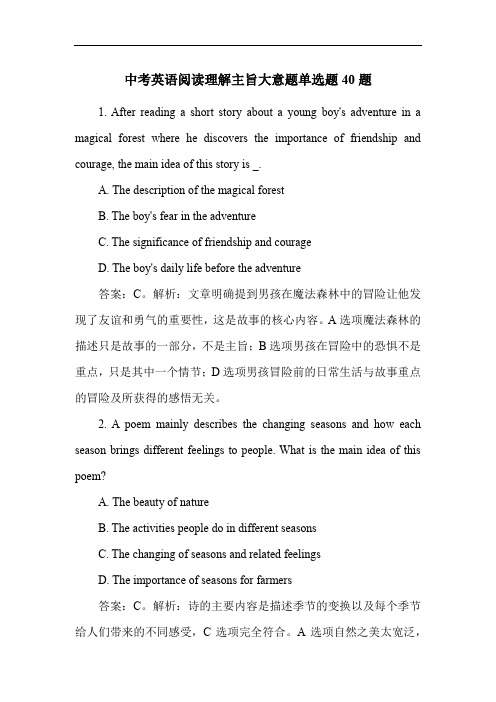
中考英语阅读理解主旨大意题单选题40题1. After reading a short story about a young boy's adventure in a magical forest where he discovers the importance of friendship and courage, the main idea of this story is _.A. The description of the magical forestB. The boy's fear in the adventureC. The significance of friendship and courageD. The boy's daily life before the adventure答案:C。
解析:文章明确提到男孩在魔法森林中的冒险让他发现了友谊和勇气的重要性,这是故事的核心内容。
A选项魔法森林的描述只是故事的一部分,不是主旨;B选项男孩在冒险中的恐惧不是重点,只是其中一个情节;D选项男孩冒险前的日常生活与故事重点的冒险及所获得的感悟无关。
2. A poem mainly describes the changing seasons and how each season brings different feelings to people. What is the main idea of this poem?A. The beauty of natureB. The activities people do in different seasonsC. The changing of seasons and related feelingsD. The importance of seasons for farmers答案:C。
解析:诗的主要内容是描述季节的变换以及每个季节给人们带来的不同感受,C选项完全符合。
精编中考英语阅读理解主旨大意题目专项训练
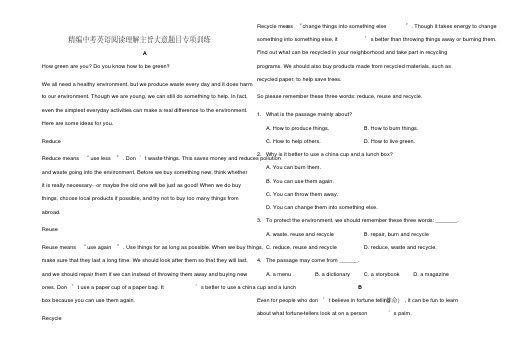
精编中考英语阅读理解主旨大意题目专项训练AHow green are you? Do you know how to be green?We all need a healthy environment, but we produce waste every day and it does harm to our environment. Though we are young, we can still do something to help. In fact, even the simplest everyday activities can make a real difference to the environment. Here are some ideas for you. ReduceReduce means “use less ”. Don ’t waste things. This saves money and reduces pollution and waste going into the environment. Before we buy something new, think whether it is really necessary —or maybe the old one will be just as good! When we do buy things, choose local products if possible, and try not to buy too many things from abroad. ReuseReuse means “use again ”. Use things for as long as possible. When we buy things, make sure that they last a long time. We should look after them so that they will last, and we should repair them if we can instead of throwing them away and buying new ones. Don ’t use a paper cup of a paper bag. It ’s better to use a china cup and a lunchbox because you can use them again. RecycleRecycle mea ns “change things into something else ”. Though it takes energy to changesomething into something else, it ’s better than throwing things away or burning them.Find out what can be recycled in your neighborhood and take part in recycling programs. We should also buy products made from recycled materials, such as recycled paper, to help save trees.So please remember these three words: reduce, reuse and recycle. 1. What is the passage mainly about?A. How to produce things.B. How to burn things.C. How to help others.D. How to live green.2. Why is it better to use a china cup and a lunch box?A. You can burn them.B. You can use them again.C. You can throw them away.D. You can change them into something else.3. To protect the environment, we should remember these three words: _______.A. waste, reuse and recycleB. repair, burn and recycleC. reduce, reuse and recycleD. reduce, waste and recycle.4. The passage may come from ______.A. a menuB. a dictionaryC. a storybookD. a magazineBEven for people who don ’t believe in fortune telling (算命), it can be fun to learn about what fortune-tellers look at on a person’s palm.。
中考英语阅读专题主旨大意题试题(共14页)
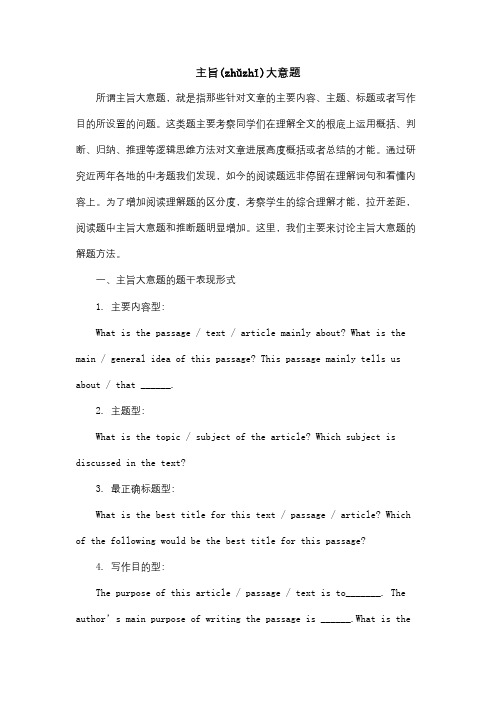
主旨(zhǔzhǐ)大意题所谓主旨大意题,就是指那些针对文章的主要内容、主题、标题或者写作目的所设置的问题。
这类题主要考察同学们在理解全文的根底上运用概括、判断、归纳、推理等逻辑思维方法对文章进展高度概括或者总结的才能。
通过研究近两年各地的中考题我们发现,如今的阅读题远非停留在理解词句和看懂内容上。
为了增加阅读理解题的区分度,考察学生的综合理解才能,拉开差距,阅读题中主旨大意题和推断题明显增加。
这里,我们主要来讨论主旨大意题的解题方法。
一、主旨大意题的题干表现形式1. 主要内容型:What is the passage / text / article mainly about? What is the main / general idea of this passage? This passage mainly tells us about / that ______.2. 主题型:What is the topic / subject of the article? Which subject is discussed in the text?3. 最正确标题型:What is the best title for this text / passage / article? Which of the following would be the best title for this passage?4. 写作目的型:The purpose of this article / passage / text is to_______. The author’s main purpose of writing the passage is ______.What is thewrit er’s purpose of writing this passage? The article has been written to explain _______.二、主旨(zhǔzhǐ)大意题的解答在做主旨大意题时,不管是哪一种题型,关键的一步是要找出主题句或者和主题有关的关键词,从而把握文章的主旨(main idea)。
中考英语阅读理解主旨大意题单选题40题
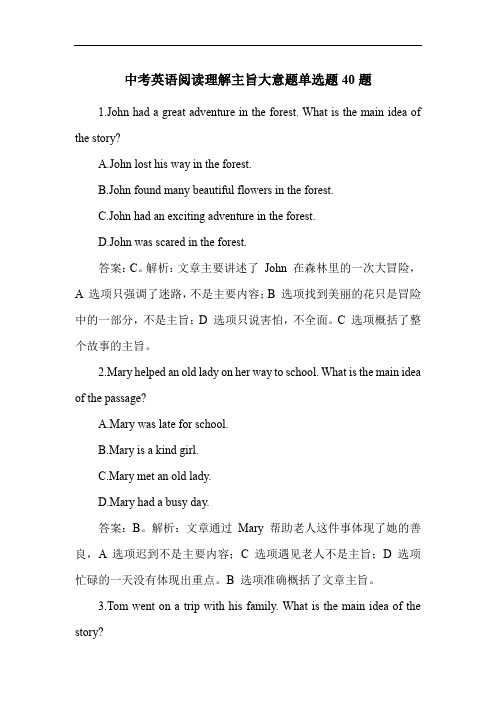
中考英语阅读理解主旨大意题单选题40题1.John had a great adventure in the forest. What is the main idea of the story?A.John lost his way in the forest.B.John found many beautiful flowers in the forest.C.John had an exciting adventure in the forest.D.John was scared in the forest.答案:C。
解析:文章主要讲述了John 在森林里的一次大冒险,A 选项只强调了迷路,不是主要内容;B 选项找到美丽的花只是冒险中的一部分,不是主旨;D 选项只说害怕,不全面。
C 选项概括了整个故事的主旨。
2.Mary helped an old lady on her way to school. What is the main idea of the passage?A.Mary was late for school.B.Mary is a kind girl.C.Mary met an old lady.D.Mary had a busy day.答案:B。
解析:文章通过Mary 帮助老人这件事体现了她的善良,A 选项迟到不是主要内容;C 选项遇见老人不是主旨;D 选项忙碌的一天没有体现出重点。
B 选项准确概括了文章主旨。
3.Tom went on a trip with his family. What is the main idea of the story?A.Tom had a lot of fun on the trip.B.Tom's family is very large.C.Tom likes to travel.D.Tom went on a long journey.答案:A。
初三英语阅读理解主旨大意和细节题综合单选题30题

初三英语阅读理解主旨大意和细节题综合单选题30题1. Read the following passage and choose the best title for it.The Internet has changed our lives in many ways. We can communicate with people all over the world easily. We can get information on almost any topic. It also provides a lot of entertainment, like movies, music and games. However, we should also be careful when using the Internet because there are some risks, such as privacy problems and false information.A. The Internet: Benefits and RisksB. How to Use the Internet for EntertainmentC. Communication on the InternetD. Information on the Internet答案:A。
解析:文章既提到了互联网给我们带来的好处,如方便交流、获取信息和娱乐,又提到了使用互联网时要小心风险,如隐私问题和虚假信息,A选项涵盖了这两方面内容。
B选项只强调了娱乐这一个好处,过于片面。
C选项只涉及交流这一个方面,不能概括全文。
D选项只提到信息这一个好处,也不能完整概括文章主旨。
2. Read the passage and select the main idea.There are different ways to keep healthy. Regular exercise is very important. It can make our bodies strong. Eating a balanced diet is also necessary. Fruits and vegetables should be included in our daily meals. And enough sleep is essential for our health as well.A. The Importance of Regular ExerciseB. Ways to Keep HealthyC. The Role of Fruits and Vegetables in HealthD. The Necessity of Enough Sleep答案:B。
初三英语阅读理解主旨大意和细节题综合单选题30题
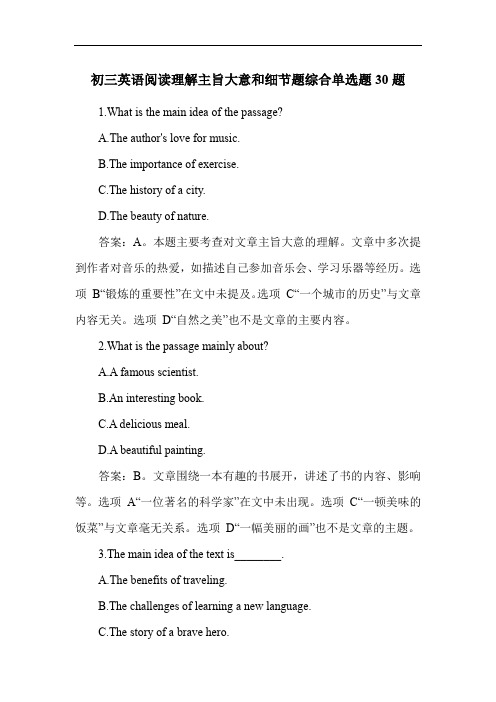
初三英语阅读理解主旨大意和细节题综合单选题30题1.What is the main idea of the passage?A.The author's love for music.B.The importance of exercise.C.The history of a city.D.The beauty of nature.答案:A。
本题主要考查对文章主旨大意的理解。
文章中多次提到作者对音乐的热爱,如描述自己参加音乐会、学习乐器等经历。
选项B“锻炼的重要性”在文中未提及。
选项C“一个城市的历史”与文章内容无关。
选项D“自然之美”也不是文章的主要内容。
2.What is the passage mainly about?A.A famous scientist.B.An interesting book.C.A delicious meal.D.A beautiful painting.答案:B。
文章围绕一本有趣的书展开,讲述了书的内容、影响等。
选项A“一位著名的科学家”在文中未出现。
选项C“一顿美味的饭菜”与文章毫无关系。
选项D“一幅美丽的画”也不是文章的主题。
3.The main idea of the text is________.A.The benefits of traveling.B.The challenges of learning a new language.C.The story of a brave hero.D.The importance of friendship.答案:D。
文中通过多个事例阐述了友谊的重要性。
选项A“旅行的好处”在文中没有体现。
选项B“学习一门新语言的挑战”不是文章重点。
选项C“一个勇敢英雄的故事”不符合文章内容。
4.What is the main purpose of the passage?A.To introduce a new product.B.To describe a beautiful place.C.To tell a funny story.D.To discuss a social problem.答案:B。
中考英语阅读理解主旨大意概括准确单选题40题答案解析版

中考英语阅读理解主旨大意概括准确单选题40题答案解析版1. A boy lost his way and was helped by a kind stranger. What is the main idea of this story?A. A boy had an adventure.B. A stranger was kind.C. A boy got lost and was helped.D. Kindness can be found everywhere.答案:C。
本题考查对记叙文主旨大意的概括。
A 选项“一个男孩有一场冒险”,文中重点并非强调冒险;B 选项“一个陌生人很善良”,没有全面概括故事;D 选项“善良随处可见”,过于宽泛。
C 选项准确概括了故事中男孩迷路并得到帮助的主要情节。
阅读技巧:注意抓住故事的关键事件进行概括。
2. A girl worked hard to achieve her dream of becoming a singer. What is the main idea?A. A girl had a dream.B. A girl was hardworking.C. A girl achieved her dream.D. Hard work leads to success.答案:C。
A 选项“一个女孩有一个梦想”不完整;B 选项“一个女孩很努力”不是主旨;D 选项“努力带来成功”比较宽泛。
C 选项准确概括了女孩实现梦想这个主要情节。
阅读技巧:关注故事的结果。
3. A family went on a trip and had many fun experiences. What is the main idea?A. A family took a trip.B. A family had fun.C. A family went on an adventure.D. Trips are fun.答案:B。
中考英语阅读理解主旨大意题50题

中考英语阅读理解主旨大意题50题1. What is the main idea of the passage?A. To introduce a famous person.B. To describe a beautiful place.C. To tell a funny story.D. To explain a scientific concept.答案:B。
解析:文章主要内容是对一个美丽地方的描述,A 选项介绍一个名人不符合文章主旨,C 选项讲一个有趣的故事也不恰当,D 选项解释一个科学概念在文章中未体现。
2. The passage is mainly about _.A. a kind of animalB. a special eventC. a popular gameD. a traditional festival答案:D。
解析:文章围绕一个传统节日展开,A 选项一种动物不是文章重点,B 选项一个特殊事件与文章不符,C 选项一个流行游戏也不是文章主要内容。
3. What can we know from the passage?A. The main character is very brave.B. The story happened in a modern city.C. The weather is very good in the story.D. The ending of the story is very sad.答案:A。
解析:文章中能明确体现出主角很勇敢,B 选项故事发生在现代城市文章未提及,C 选项天气情况文章未描述,D 选项故事结局悲伤文章也未体现。
4. The main purpose of the passage is _.A. to teach people how to do somethingB. to make people laughC. to give information about somethingD. to persuade people to do something答案:C。
中考英语阅读理解主旨大意单选题50题
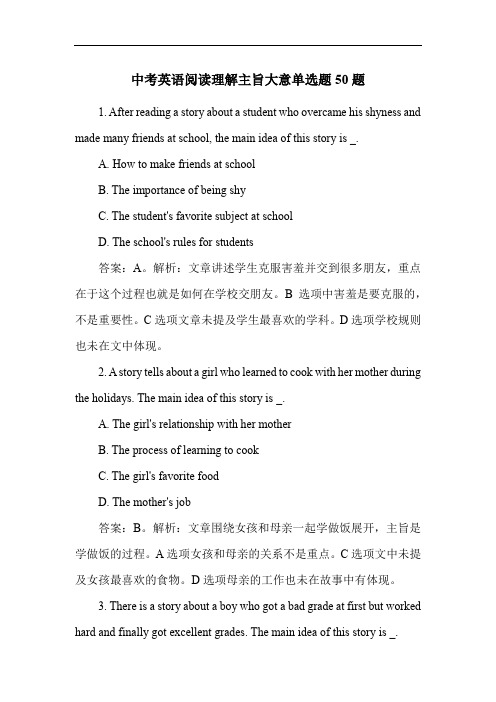
中考英语阅读理解主旨大意单选题50题1. After reading a story about a student who overcame his shyness and made many friends at school, the main idea of this story is _.A. How to make friends at schoolB. The importance of being shyC. The student's favorite subject at schoolD. The school's rules for students答案:A。
解析:文章讲述学生克服害羞并交到很多朋友,重点在于这个过程也就是如何在学校交朋友。
B选项中害羞是要克服的,不是重要性。
C选项文章未提及学生最喜欢的学科。
D选项学校规则也未在文中体现。
2. A story tells about a girl who learned to cook with her mother during the holidays. The main idea of this story is _.A. The girl's relationship with her motherB. The process of learning to cookC. The girl's favorite foodD. The mother's job答案:B。
解析:文章围绕女孩和母亲一起学做饭展开,主旨是学做饭的过程。
A选项女孩和母亲的关系不是重点。
C选项文中未提及女孩最喜欢的食物。
D选项母亲的工作也未在故事中有体现。
3. There is a story about a boy who got a bad grade at first but worked hard and finally got excellent grades. The main idea of this story is _.A. The boy's hard - working processB. The boy's favorite teacherC. The boy's hobbies outside schoolD. The boy's family members答案:A。
中考英语阅读理解主旨大意题单选题30题

中考英语阅读理解主旨大意题单选题30题1. The passage is mainly about _____.A. the person's hobbiesB. the person's achievementsC. the person's familyD. the person's personality答案:B。
解析:文章主要讲述了这个人在事业上取得的成就,A 选项“爱好”并非重点,C 选项“家庭”在文中提及较少,D 选项“性格”不是主要内容。
2. What is the main idea of the text?A. How the person overcame difficulties.B. The person's early life experiences.C. The person's influence on others.D. The person's contributions to society.答案:D。
解析:文章重点强调了这个人对社会的贡献,A 选项“克服困难”只是部分内容,B 选项“早期生活经历”并非主旨,C 选项“对他人的影响”不是主要表达的意思。
3. The main purpose of this passage is to _____.A. describe the person's dreamsB. introduce the person's friendsC. show the person's character traitsD. tell the story of the person's life答案:D。
解析:整篇文章是在讲述这个人的一生的故事,A 选项“梦想”不是核心,B 选项“朋友”并非重点,C 选项“性格特点”只是其中一部分。
4. What does the passage focus on?A. The person's travel experiencesB. The person's education backgroundC. The person's career developmentD. The person's relationship with family答案:C。
中考英语复习之考题精练 阅读理解--主旨大意题、推理判断题

基础自查
考点汇聚
随堂演练
课后作业
Part Two
基础自查
考点汇聚
随堂演练
课后作业
主要透过文章表面信息推测文章隐含意思或对 作者的态度意图及文章细节的发展做出推理判断。
① The passage / author implies/ suggests that
② It can be inferred from the text that___.
Q: From Para.3, we learn that Thomas was _______.
A. sad
B. optimistic C. ambitious
D. grateful
基础自查
考点汇聚
随堂演练
课后作业
Planning a visit to the UK? Here we help with ways to cut your costs.
A. the future of print books is controlled by readers. B. digital books will take the place of print ones soon. C. paperless libraries and the traditional ones should coexist(共存). D. people will lose their interest in reading books in the future.
A. Cigarette smoking can cause cancer B. Smoking can cause the most serious and terrible disease (illness) C. Smoking also can cause other health problems D. Smoking is harmful.
初三英语阅读主旨大意单选题40题

初三英语阅读主旨大意单选题40题1. The passage mainly tells about a young boy's adventure in the forest. Which of the following best expresses the main idea?A. The boy's fear in the forestB. The boy's discovery during the adventureC. The beautiful scenery in the forestD. The boy's preparation before the adventure答案:B。
解析:文章主要讲述男孩在森林中的冒险,重点在于冒险过程中的发现。
A选项男孩在森林中的恐惧只是冒险中的一部分,不能概括全文;C选项森林的美景并非重点,不是主旨;D选项男孩冒险前的准备不是文章主要内容,偏离主旨。
2. An article is about how to protect the environment in our daily life. What is the main idea?A. The importance of recyclingB. Different ways to protect the environmentC. The harm of environmental pollutionD. The role of the government in environmental protection答案:B。
解析:文章是关于日常生活中如何保护环境,B选项不同的保护环境的方法能很好地概括主旨。
A选项回收利用的重要性只是保护环境的一种方式,比较片面;C选项环境污染的危害不是文章重点;D选项政府在环保中的角色并非文章主要论述内容。
3. The passage is a story about a girl who overcame difficulties toachieve her dream of becoming a dancer. Which option sums up the main idea?A. The girl's family supportB. The girl's hard training processC. The girl's achievement of her dancing dreamD. The setbacks the girl faced答案:C。
初三英语阅读理解主旨大意和细节题综合单选题30题

初三英语阅读理解主旨大意和细节题综合单选题30题1.The main idea of the story is about a boy who_____.A.likes playing footballB.helps an old manC.goes on a tripD.studies hard答案:B。
本题考查主旨大意。
文章主要讲述了一个男孩帮助一位老人的故事。
A 选项喜欢踢足球与文章主旨不符;C 选项去旅行也不是文章主要内容;D 选项努力学习在文中未提及。
2.The boy in the story meets the old man_____.A.in a parkB.at schoolC.on a busD.in a store答案:A。
本题考查细节理解。
文中明确提到男孩在公园遇到老人。
B 选项在学校、C 选项在公交车上、D 选项在商店都不符合文章内容。
3.What does the boy do for the old man?A.Buys him food.B.Helps him find his way home.C.Gives him money.D.Talks to him.答案:B。
本题考查细节理解。
文章中讲述男孩帮助老人找到回家的路。
A 选项买食物、C 选项给钱、D 选项和他聊天在文中未体现。
4.The old man is_____.A.kindB.lonelyC.angryD.happy答案:B。
本题考查细节理解。
从文章中可以推断出老人是孤独的,因为他需要别人帮助他回家。
A 选项善良、C 选项生气、D 选项开心在文中没有体现。
5.At the end of the story, the boy_____.A.goes homeB.stays with the old manC.meets his friendsD.helps another person答案:A。
本题考查细节理解。
中考英语听力理解主旨大意题练习题40题
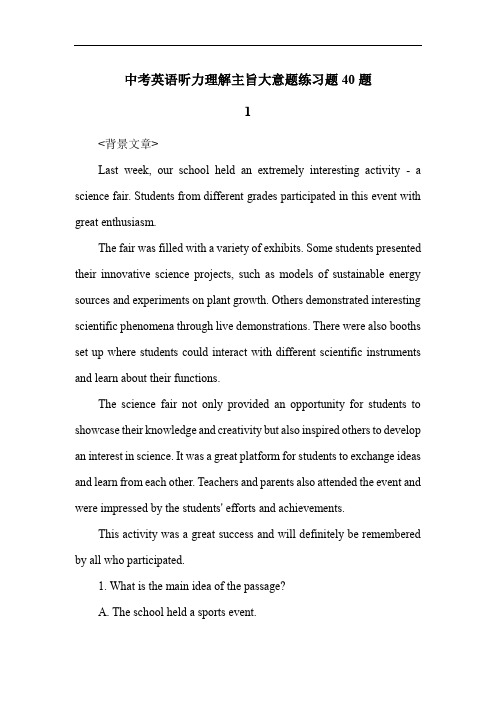
中考英语听力理解主旨大意题练习题40题1<背景文章>Last week, our school held an extremely interesting activity - a science fair. Students from different grades participated in this event with great enthusiasm.The fair was filled with a variety of exhibits. Some students presented their innovative science projects, such as models of sustainable energy sources and experiments on plant growth. Others demonstrated interesting scientific phenomena through live demonstrations. There were also booths set up where students could interact with different scientific instruments and learn about their functions.The science fair not only provided an opportunity for students to showcase their knowledge and creativity but also inspired others to develop an interest in science. It was a great platform for students to exchange ideas and learn from each other. Teachers and parents also attended the event and were impressed by the students' efforts and achievements.This activity was a great success and will definitely be remembered by all who participated.1. What is the main idea of the passage?A. The school held a sports event.B. The school held a science fair.C. The school held an art exhibition.D. The school held a music concert.答案:B。
- 1、下载文档前请自行甄别文档内容的完整性,平台不提供额外的编辑、内容补充、找答案等附加服务。
- 2、"仅部分预览"的文档,不可在线预览部分如存在完整性等问题,可反馈申请退款(可完整预览的文档不适用该条件!)。
- 3、如文档侵犯您的权益,请联系客服反馈,我们会尽快为您处理(人工客服工作时间:9:00-18:30)。
精编中考英语阅读理解主旨大意题目专项训练AHow green are you? Do you know how to be green?We all need a healthy environment, but we produce waste every day and it does harm to our environment. Though we are young, we can still do something to help. In fact, even the simplest everyday activities can make a real difference to the environment. Here are some ideas for you.ReduceReduce means “use less”. Don’t waste things. This saves money and reduces pollution and waste going into the environment. Before we buy something new, think whether it is really necessary—or maybe the old one will be just as good! When we do buy things, choose local products if possible, and try not to buy too many things from abroad.ReuseReuse means “use again”. Use things for as long as possible. When we buy things, make sure that they last a long time. We should look after them so that they will last, and we should repair them if we can instead of throwing them away and buying new ones. Don’t use a paper cup of a paper bag. It’s better to use a china cup and a lunch box because you can use them again.Recycle Recycle means “change things into something else”. Though it takes energy to change something into something else, it’s better than throwing things away or burning them. Find out what can be recycled in your neighborhood and take part in recycling programs. We should also buy products made from recycled materials, such as recycled paper, to help save trees.So please remember these three words: reduce, reuse and recycle.1.What is the passage mainly about?A. How to produce things.B. How to burn things.C. How to help others.D. How to live green.2.Why is it better to use a china cup and a lunch box?A. You can burn them.B. You can use them again.C. You can throw them away.D. You can change them into something else.3.To protect the environment, we should remember these three words: _______.A. waste, reuse and recycleB. repair, burn and recycleC. reduce, reuse and recycleD. reduce, waste and recycle.4.The passage may come from ______.A. a menuB. a dictionaryC. a storybookD. a magazineBEven for people who don’t believe in fortune telling(算命), it can be fun to learn about what fortune-tellers look at on a person’s palm.To read a person’s fortune, a fortune-teller looks at both of the person’s hands. They say the hand that a person uses for writing will show the things the person has done in life and the choices he or she has made. Fortune-teller say the person’s other hand will show the abilities they were born with and their future.In looking at each hand, fortune-teller say that different lines on the hand stand for things about a person’s life. For example, they call the three major lines on people’s hands the head line, the heart line, and the life line.The head line stands for intelligence--- people with a long head line are said to have an excellent memory, while those with a short one are very intelligent. The life line represents health, and the longer it is , the healthier someone is . The heart line represents emotions and relationships-as a rule, the longer it is , the more important relationships are to that person.Fortune-teller also look at six minor lines, but quite a lot of people do not have one or more of the minor lines. The minor lines are said to represent things such as the person’s fate, wealth health, marriage life, and children. Fortune-tellers read these lines by looking at how deep and how long each line is .In addition, fortune-tellers believe they can read information from the fingers of the hand. Each finger has a certain skill or fortune related to it. The thumb is related to love, the index finger to leadership, the middle finger to fate, the ring finger to art and imagination, and the smallest finger to communication. A fortune-teller will look at the length of each finger, how the finger bends , the size of the joints, and the shape of the ends of the fingers.5.What is the main topic of the passage?A. How fortune-tellers read palms.B. A famous fortune-tellerC. The history of palm reading.D. Why palm reading is popular today?6.What should a fortune-teller look at to read a person’s future?A. The back of the person’s hand.B. The hand not used for writing.C. The fingers of the left hand.D. The person’s stronger hand7.What is true about the minor lines on the palm?A. Some people might not have all of them.B. The lines make the meaning of the fingers stronger.C. Few people are interested in these lines.D. They are more difficult for fortune-tellers to read.8.If a person has a long index finger with a good shape, which job would probablysuit the person?A. Actor.B. JournalistC. ManagerD. Writer9.Which is Not important for reading palms?A. The depth of the lines.B. The size of the hand.C. The length of the fingersD. Which hand is used.CIt was a winter morning, just a few weeks before Christmas. While most people were warming up their cars, Trevor, my husband, had to get up early to ride his bike four kilometers away from home to work. When he arrived, he parked his bike outside the back door as he usually does. After working for 10 hours, he returned to find his bike gone.The bike,a black Kona 18 speed, was our only transport. Trevor used“to get to work, putting in 60 -hour weeks to support his young family. And the bike was also used to get groceries, saving us from having to walk long distances from where we live.I was so sad that someone would steal our bike that l wrote to the newspaper and told them our story. Shortly after that, several people in our area offered to help. One wonderful stranger even bought a bike, and then called my husband to pick it up. Once again my husband had a way to get to and from his job. It really is an honor that a complete stranger would go out of their way for someone they have never met before.People say that a smile can be passed from one person to another, but acts of kindness from strangers are even more so. This experience has had a strong and wide effect in our lives because it made us believe strongly in there's love between people. No matter how big or how small, an act of kindness shows that someone cares. And the results can be everlasting.10.Why was the bike so important to the couple?A. The man's job was bike racingB. It was their only worthy thing.C. It was a nice Kona 18 speed.D. They used it for work and daily life.11.What can we infer from the text?A. The writer worked 60 hours a week.B. People were busy before Christmas.C. The stranger brought over the bike.D. Life was hard for the young family.12.How did people get to know the couple's problem?A. From radio broadcasts.B. From a newspaper.C. From TV news.D. From a stranger.13.Which of the following is TRUE?A. The writer's husband often parked the bike beside the back door.B. The writer used to get to work with her husband on their bikes.C. Several strangers offered help, but they only accepted one bike.D. Somebody had stolen their bike before, but soon returned it to them.14.What do the writer and her husband learn from their experience?A. An act of kindness can mean a lot.B. One should take care of his bike.C. News reports make people famous.D. Strangers are usually of little help.DWhen the six very best students from different cities in Guangdong Province all together chose universities in Hong Kong; when the very best students of Beijing picked up HK University while giving up the nearby Beijing or Qinghua University; when the highest enrollment (录取) rate of Hong Kong Science and Industry University reached 48︰1, itˈs the high time to ask what happened to the education in China .Years ago, the answer certainly would be "Beijing or Qinghua University". But now no one could give the exact answer without thinking twice. The only sure thing is that HK universities have gradually showed an unusual attraction to a great many mainland students.Itˈs no doubt to call this HK craze (狂热,发狂), which even surprised HK universities themselves.How can HK universities come before Beijing and Qinghua University and attract so many mainland students?First, Hong Kong universities offer large-amount sholarship (奖学金), especially for the top students who can receive the sum scholarship as much as 400,000 HK dollars. Since a number of families find it a little difficult to afford higher education, itˈs easy to understand why HK universities are their first choices.Second, most HK universities receive professors and students from all over the world and both Chinese and English are spoken in class. This kind excellent language atmosphere (氛围) is another attraction for mainland students.Furthermore, university students in Hong Kong have a better chance to study abroad as exchange students.Can mainland top universities like Beijing or Qinghua University be calm as before when facing the unexpected competition from HK? Will they take measures (采取措) to win back the top students who once help them set the worldwide reputation (名声,名誉)? Time will explain it.The fierce competition brought by HK universities can be a good thing for the Whole improvement of education in China, After the awakening and action-taking of mainland universities, they can perform better together with HK universities. At least, it reminded the mainland universities the tuition fees (学费) are what students have to consider when they are choosing universities. Itˈs time to move.15.What is the passage mainly talking about?A. Mainland universities and Hong Kong Universities.B. Different educations between Hong Kong and Mainland.C. Some thoughts brought by the enrollment of HK universities.D. The competition between HK University and Beijing University.16.From the passage we can see HK universities ________.A. are proud of their high reputationB. didnˈt mean to enroll top students from mainlandC. have strict enrollment rules and better learning resourcesD. didnˈt expect they are so popular among mainland students17.What does the writer mean by saying "Itˈs time to move." in the last paragraph?A. Top students had better move abroad to study in universities.B. Top students should be offered further education without any pay.C. Mainland universities should make full preparations to enroll Hong Kongstudents.D. Mainland universities should take measures as soon as possible to attractstudents.参考答案1. D2. B3. C4. D5. A6. B7. A8. C9. B10. D11. D12. B13. C14. A15. C16. D 17. D。
